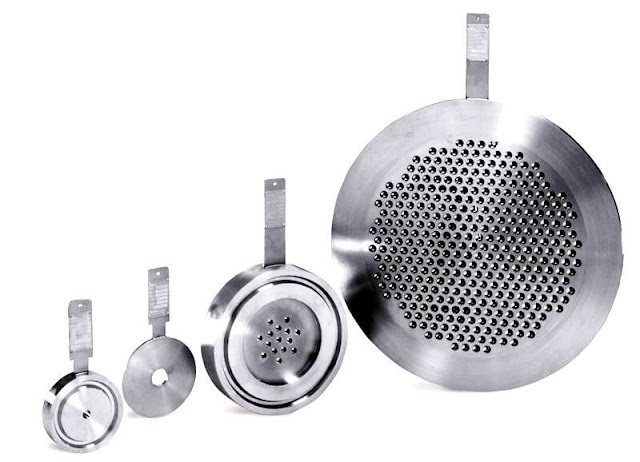A single stage multi-hole restriction orifice plate is used to abate the noise generated by the device due to high velocity through the bore which offers restriction to the incoming fluid.
The flow at the inlet is now channeled into several streams through the multiple holes and this reduces the noise which would be otherwise will be above the acceptable limit if a single hole device is used.
(iii) Multi-stage restriction orifice plate assembly
These devices are used where the pressure reduction ratio is very high and cannot be achieved by a single stage orifice plate. Thus a multistage device essentially consists of a number of single stage device built in a single spool.
Like a single stage device it can be of single hole multi stage design or multi-hole multi-stage design or combination of both.
(iV) Conical shaped restriction orifice plate
Solve problems associated with orifice cavitation (Erosion, vibration, noise)
Eliminated damage caused by cavitation
*Energy dissipated inside the cone of the orifice, not at pipe wall
*Conical orifice allows energy to dissipate before striking pipe wall
Application of Restriction Orifice Plates
Followings are a few examples of common applications where these restriction orifice devices are used to achieve controlled flow from the upstream to the downstream.
Restriction orifices are often exposed to severe flow conditions associated with large pressure reductions and the related fluid conditions caused by liquids flashing to a gas, cavitation, and sonic (choked) flow. Hence such conditions also are taken into consideration.
(i) Restriction Orifice (RO) at the downstream of blowdown valves
These are used to ensure controlled flow rate in a blowdown piping or blowdown header.
When the blowdown valve (which is usually a FB or RB ball valve) opens to release the high pressure on its upstream, the restriction orifice plate at its downstream ensures that the flow is not excessive to overload the flare header.
Usually the pressure drop in blowdown circuit across the restriction orifice could be very high say, typically 80-100 bar. If high pressure drop is achieved through a single stage device or by a device with not too many stages, there will be fall in temperature during the blowdown event due to Joule Thompson effect. Thus the design of the RO needs to take care of the low temperature.
(ii) Restriction Orifice (RO) in pump re-circulation line
ROs are also used in centrifugal pump’s re-circulation line where a constant re-circulation flow is required and control of re-circulation and forward flow rate is not important.
The re-circulation ensures that cavitations / starvation cannot happen in the pump.
(iii) Restriction Orifice (RO) to restrict gas blow-by
A typical case is the flow of hydrocarbon condensate from the high pressure separator to the low pressure separator.
Usually a level control valve (LCV) controls the level of the high pressure separator. In case of the valve failure, the valve needs to open fully to stop separator from overflowing.
Full open of LCV is accompanied by high rate of flow of condensate followed by flow of gas. To stop the downstream relieving system from overloading the gas flow is controlled by a restriction orifice at the downstream of the LCV.
Similar application is seen in the heating medium flow into re-boiler to mitigate the effect of heating medium valve fail open position.
(iv) Restriction Orifice (RO) to check excess flow
ROs are used to restrict the excessive flow in case of a rupture.
Thus in Well head applications if the down holes valves to be closed due to fire, the hydraulic power oil to the valve actuator is depressurized by the use of fusible plug which fuses and allows the hydraulic oil to leak through a RO at a restricted flow rate.
(v) Restriction Orifice (RO) for controlled pressurization
During the start-up of a process plant, many plant sections are required to be pressurized with the incoming process fluid in controlled manner.
This is because the upstream section will be usually at a much higher pressure than the downstream.
Thus if there is no restriction on the flow rate, the initial flow rate may be very high and may damage the pipe line and equipment.
ROs are used for gradual pressurization. To restrict the flow the ideal condition is to design for the choked flow for gas.
As during the choked flow, the rate of flow will be less as it will be proportional to the square root of inlet pressure rather than to the differential pressure.
Codes & Standards
Though no internationally reputed codes and standards exist which directly address a restriction orifice but there are associated references and some are listed below:
(i) ISO 5167 Part 1: Measurement of fluid flow by means of pressure differential devices inserted in circular cross-section conduits running full – Part 1: General principles and requirements.
(ii) ISO 5167 Part 2: Measurement of fluid flow by means of pressure differential devices inserted in circular cross-section conduits running full – Part 2: Orifice plates.
(iii) IEC 60534-8-3: Industrial-process control valves – Part 8-3: Noise considerations –Control valve aerodynamic noise prediction method.




Comments
Post a Comment